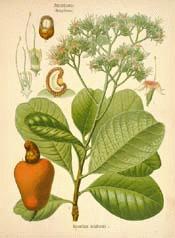
Botanical.com Home Page

|
Cashew Nut
(Anacardium occidentale)
Click on graphic for larger image
|
Cashew Nut
Botanical: Anacardium occidentale (LINN.)
Family: N.O. Anacardiaceae
---Synonym---Cassavium pomiferum.
---Part Used---Nut.
---Habitat---Jamaica, West Indies, and other parts of tropical America.
---Description---A medium-sized tree, beautiful, and not unlike in appearance the walnut tree, with oval blunt alternate leaves and scented rose-coloured panicles of bloom - the tree produces a fleshy receptacle, commonly called an apple, at the end of which the kidney-shaped nut is borne; the end of it which is attached to the apple, is much bigger than the other. The outer shell is ashy colour, very smooth, the kernel is covered with an inner shell, and between the two shells is found a thick inflammable caustic oil, which will raise blisters on the skin and be dangerously painful if the nuts are cracked with the teeth.
---Constituents---Two peculiar principles have been found: Anacardic Acid and a yellow oleaginous liquid Cardol.
---Medicinal Action and Uses---The oil must be used with great caution, but has been successfully applied to corns, warts, ringworms, cancerous ulcers and even elephantiasis, and has been used in beauty culture to remove the skin of the face in order to grow a new one. The nuts are eaten either fresh or roasted, and contain a milky juice which is used in puddings. The older nuts are roasted and salted and the dried and broken kernels are sometimes imported to mix with old Madeira as they greatly improve its flavour. In roasting great care must be taken not to let the fumes cover the face or hands etc., as they cause acute inflammation an external poisoning. Ground and mixed with cocoa the nuts make a good chocolate. The fruit is a reddy yellow and has a pleasant sub-acid stringent taste, the expressed juice of the fruit makes a good wine, and if distilled, a spirit much better than arrack or rum. The fruit itself is edible, and its juice has been found of service in uterine complaints and dropsy. It is a powerful diuretic. The black juice of the nut and the milky juice from the tree after incision are made into an indelible marking-ink- the stems of the flowers also give a milky juice which when dried is hard and black and is used as a varnish. A gum is also found in the plant having the same qualities as gumarabic; it is imported from South America under the name of Cadjii gum, and used by South American bookbinders, who wash their books with it to keep away moths and ants. The caustic oil found in the layers of the fruit is sometimes rubbed into the floors of houses in India to keep white ants away.
---Other Species---
The Oriental Anacardium or Cashew Nut (Semecarpus anacardium), a native of India, has similar qualities to the West Indian Cashew, and is said to contain an alkaloid called Chuchunine.
Ammonium anarcadate. This is the Ammonium compound of beta and delta resinous acids of A. occidentale (Cashew Nut), and is used as a hair-dye, but cannot be used with acids, acid salts, or acetate of lead.
[Top]
Common Name Index
A MODERN HERBAL Home Page
Bear in mind "A Modern Herbal" was written with the conventional wisdom of the early 1900's. This should be taken into account as some of the information may now be considered inaccurate, or not in accordance with modern medicine.
© Copyright Protected 1995-2025 Botanical.com
|

